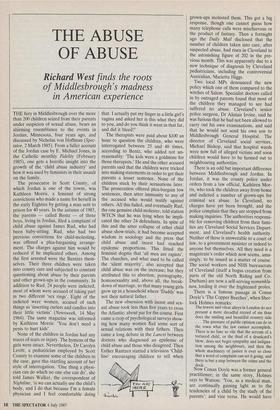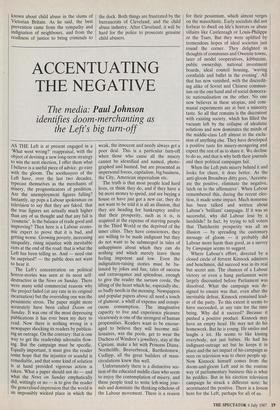THE ABUSE OF ABUSE
of Middlesbrough's madness in American experience
THE fury in Middlesbrough over the more than 200 children seized from their parents under suspicion of sexual abuse, bears an alarming resemblance to the events in Jordan, Minnesota, four years ago, and discussed by Nicholas von Hoffman (Spec- tator, 2 March 1985). From a fuller account of the Jordan case by E. Michael Jones, in the Catholic monthly Fidelity (February 1985), one gets a horrific insight into the growth of the 'child abuse industry' and how it was used by feminists in their assault on the family.
The prosecutor in Scott County, of which Jordan is one of the towns, was Kathleen Morris, a feminist of strong convictions who made a name for herself in the early Eighties by getting a man sent to prison for 40 years. In the autumn of 1983, the parents — called Bentz — of three boys, living in Jordan, filed a complaint of child abuse against James Rud, who had been baby-sitting. Rud, who had two previous convictions for child-molesting, was offered a plea-bargaining arrange- ment. The charges against him would be reduced if he implicated others. Among the first arrested were the Bentzes them- selves. Their three children were taken into county care and subjected to constant questioning about abuse by their parents and other grown-ups in the community. In addition to Rud, 24 people were indicted, most of whom were accused of taking part in two different 'sex rings'. Eight of the indicted were women, accused of such things as 'inserting curlers and candles into their little victims' (Newsweek, 14 May 1984). The same magazine was informed by Kathleen Morris: 'You don't need a penis to hurt kids'.
None of the children in Jordan had any traces of scars or injury. The hymens of the girls were intact. Nevertheless, Dr Carolyn Levitt, a pediatrician employed by Scott County to examine some of the children in the case, gave this startling account of her style of interrogation. 'One thing a physi- cian can do which no one else can do', she told James Walker, the correspondent of Nightline, 'is we can actually use the child's body, and I do that because I'm a female physician and I feel comfortable doing that. I actually put my finger in a little girl's vagina and asked her is this what they did to you, and do you think it went in that far, and did it bleed?'
The therapists were paid about $100 an hour to question the children, who were interrogated between 25 and 40 times, according to Bentz, who added not un- reasonably: 'The kids were a goldmine for those therapists.' He and the other accused parents said that the children were tricked into making statements in order to get their parents a lesser sentence. None of the children stuck by their accusations later. The prosecution offered plea-bargain low sentences, then utter immunity to any of the accused who would testify against others. All this failed, and eventually Rud, the one genuine child molester, told station WTCN that he was lying when he impli- cated the other 24 defendants. In spite of this and the utter collapse of other child abuse show-trials, it had become accepted wisdom in sociology and the press that child abuse and incest had reached epidemic proportions. This fitted the feminist dogma that 'all men are rapists'. The churches, and what used to be called the 'silent majority', also accepted that child abuse was on the increase; but they attributed this to abortion, pornography, homosexuality and, above all, the break- down of marriage, so that many young girls grew up in a household where 'Daddy' was not their natural father.
The new obsession with incest and sex- ual abuse took less than five years to cross the Atlantic: about par for the course. First came a crop of psychological surveys show- ing how many women liad some sort of sexual relations with their fathers. Then came a long debate in the Lancet between doctors who diagnosed an epidemic of child abuse and those who disagreed. Then Esther Rantzen started a television 'Child- line' encouraging children to tell when grown-ups molested them. This got a big response, though one cannot guess how many telephone calls were mischievous or the product of fantasy. Then a fortnight ago the Daily Mail disclosed that the number of children taken into care, after suspected abuse, had risen in Cleveland to the astonishing figure of 202 in the pre- vious month. This was apparently due to a new technique of diagnosis by Cleveland pediatricians, including the controversial Australian, Marietta Higgs.
Two local MPs denounced the new policy which one of them compared to the witches of Salem. Specialist doctors called in by outraged parents found that most of the children they managed to see had suffered no abuse. Cleveland's senior police surgeon, Dr Alistair Irvine, said he was furious that he had not been allowed to carry out his own examinations, and said that he would not send his own son to Middlesbrough General Hospital. The director of Cleveland social services, Michael Bishop, said that hospital wards were now full of alleged victims and soon children would have to be farmed out to neighbouring authorities.
There is an odd but important difference between Middlesbrough and Jordan. In Jordan, it was the county police under orders from a law official, Kathleen Mor- ris, who took the children away from home and indicted a number of grown-ups for criminal sex abuse. In Cleveland, no charges have yet been brought, and the police complain that they are stopped from making inquiries. The authorities responsi- ble for removing children from their fami- lies are Cleveland Social Services Depart- ment, and Cleveland's health authority.
Neither of these is answerable to a court of law, to a government minister or indeed to anyone but themselves. All they need is a magistrate's order which now seems, ama- zingly, to be issued as a matter of course.
The social workers and NHS bureaucrats of Cleveland (itself a bogus creation from parts of the old North Riding and Co. Durham) are now a self-serving nomenkla- tura, lording it over the frightened proles. There is a famous passage in Conan Doyle's 'The Copper Beeches', when Sher- lock Holmes remarks:
The lowest and vilest alleys in London do not present a more dreadful record of sin than does the smiling and beautiful country side . . . The pressure of public opinion can do in the town what the law cannot accomplish. There is no lane so vile that the scream of a tortured child, or the thud of a drunkard's blow, does not beget sympathy and indigna- tion among the neighbours, and then the whole machinery of justice is ever so close that a word of complaint can set it going, and there is but a step between the crime and the dock.
Now Conan Doyle was a former general practitioner; in the same story, Holmes says to Watson: 'You, as a medical man, are continually gainiiig light as to the tendencies of a child by the study of the parents'; and vice versa. He would have known about child abuse in the slums of Victorian Britain. As he said, the best prevention came from the sympathy and indignation of neighbours, and from the readiness of justice to bring criminals to the dock. Both things are frustrated by the bureaucrats of Cleveland, and the child abuse industry. After Cleveland, it will be hard for the police to prosecute genuine child abusers.



















































 Previous page
Previous page